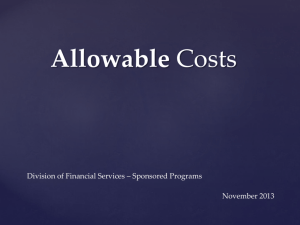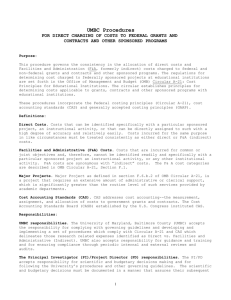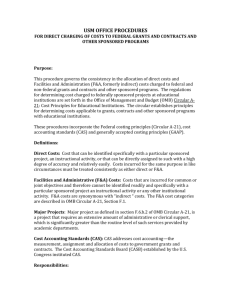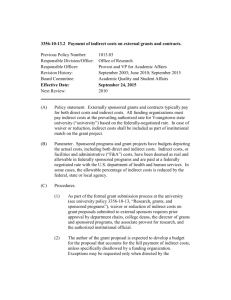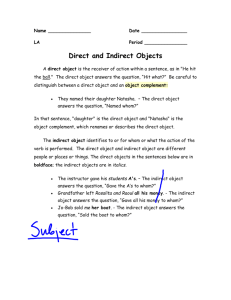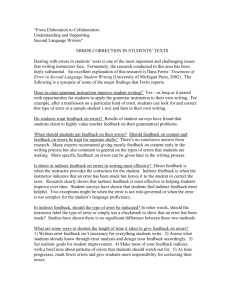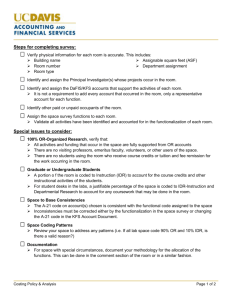Direct Costs vs. Indirect Costs
advertisement
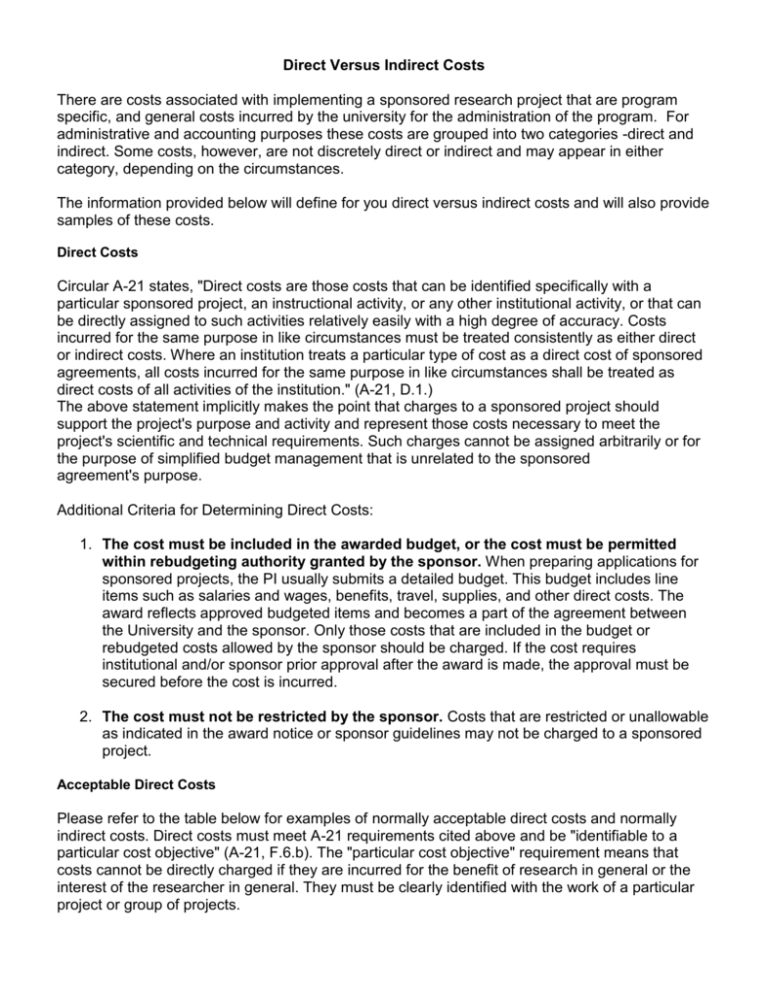
Direct Versus Indirect Costs There are costs associated with implementing a sponsored research project that are program specific, and general costs incurred by the university for the administration of the program. For administrative and accounting purposes these costs are grouped into two categories -direct and indirect. Some costs, however, are not discretely direct or indirect and may appear in either category, depending on the circumstances. The information provided below will define for you direct versus indirect costs and will also provide samples of these costs. Direct Costs Circular A-21 states, "Direct costs are those costs that can be identified specifically with a particular sponsored project, an instructional activity, or any other institutional activity, or that can be directly assigned to such activities relatively easily with a high degree of accuracy. Costs incurred for the same purpose in like circumstances must be treated consistently as either direct or indirect costs. Where an institution treats a particular type of cost as a direct cost of sponsored agreements, all costs incurred for the same purpose in like circumstances shall be treated as direct costs of all activities of the institution." (A-21, D.1.) The above statement implicitly makes the point that charges to a sponsored project should support the project's purpose and activity and represent those costs necessary to meet the project's scientific and technical requirements. Such charges cannot be assigned arbitrarily or for the purpose of simplified budget management that is unrelated to the sponsored agreement's purpose. Additional Criteria for Determining Direct Costs: 1. The cost must be included in the awarded budget, or the cost must be permitted within rebudgeting authority granted by the sponsor. When preparing applications for sponsored projects, the PI usually submits a detailed budget. This budget includes line items such as salaries and wages, benefits, travel, supplies, and other direct costs. The award reflects approved budgeted items and becomes a part of the agreement between the University and the sponsor. Only those costs that are included in the budget or rebudgeted costs allowed by the sponsor should be charged. If the cost requires institutional and/or sponsor prior approval after the award is made, the approval must be secured before the cost is incurred. 2. The cost must not be restricted by the sponsor. Costs that are restricted or unallowable as indicated in the award notice or sponsor guidelines may not be charged to a sponsored project. Acceptable Direct Costs Please refer to the table below for examples of normally acceptable direct costs and normally indirect costs. Direct costs must meet A-21 requirements cited above and be "identifiable to a particular cost objective" (A-21, F.6.b). The "particular cost objective" requirement means that costs cannot be directly charged if they are incurred for the benefit of research in general or the interest of the researcher in general. They must be clearly identified with the work of a particular project or group of projects. Direct Costs Non-administrative Salaries, Wages, Fringe Benefits, such as: Principal investigator Research assistant Technician Faculty Scientist Post-Doc. Animals and Animal Care Auto Rental Consultants Duplicating Equipment (Technical & Scientific) Maintenance/Repair – Scientific Equipment Page Charges/Reprints/Reference Materials Freight/Other Transportation UPS, Fed Ex Priority Mail Rental of Space or Equipment (Non-University Owned) Service/Recharge Center Charges Subcontracts Materials & Supplies Chemical laboratory Gases Radioisotopes Telephone Charges – Long Distance Indirect Costs Administrative and Clerical Salaries, Wages, Fringe Benefits, such as: Fiscal officer Secretary Department Administrator Accountant Staff assistant Administrative staff officer Computer Hardware (General Purpose) Dues & Memberships Equipment (General Purpose) Copier Office Furniture Maintenance/Repair – General Purpose Equipment Meals & Refreshments Printing Postage Subscriptions Office Supplies Pens, pencils Paper, tablets Files, folders, binders Transparencies Staples Computer software (general) Telephone Charges – Basic Basic line charge Local calls Pagers Voice mail Indirect Costs or Facilities and Administrative (F&A) Costs Indirect costs are defined in A-21 as "those that are incurred for common or joint objectives (of the University) and, therefore, cannot be identified readily and specifically with a particular sponsored project, an instructional activity or any other institutional activity." (A-21, E1.) These costs are also referred to as "Facilities and Administrative" and are comprised of a number of components. Facilities includes "depreciation and use allowances, interest on debt associated with certain buildings, equipment and capital improvements, operation and maintenance expenses, and library expenses. Administration is defined as general administration and general expenses, departmental administration, sponsored projects administration, student administration and services, and all other types of expenditures not listed specifically under... Facilities." (A-21,F.1.) At the college and department level "salaries of administrative and clerical staff...(and) items such as office supplies, postage, local telephone cost, and memberships shall normally be treated as F&A costs." (A-21, F.6.B) Costs incurred for the same purpose in like circumstances must be consistently treated by the University as either direct or indirect. Charging Normally Indirect Costs to Sponsored Projects A-21 does not absolutely prohibit costs identified by the institution as normally indirect from being charged directly to a sponsored agreement. However, strict criteria must be met. Costs normally treated by the University as indirect may be charged to a sponsored project when ALL of the following conditions are met: 1. The costs can be readily identified specifically with the project with a high degree of accuracy; and 2. The cost is explicitly budgeted, with justification, and awarded: a. The cost is separately budgeted in the proposal budget (note that for certain fixedprice funding arrangements a detailed budget is not required by the sponsor, however, the internal budget should reflect the cost); If you think your program has a cost that would typically be considered an indirect cost but you feel there is justification to include as a direct cost in your program, please contact the Grants office to discuss before including the cost in your budget. Please contact either Angie Johnson or Todd Doman at extension 4431.
